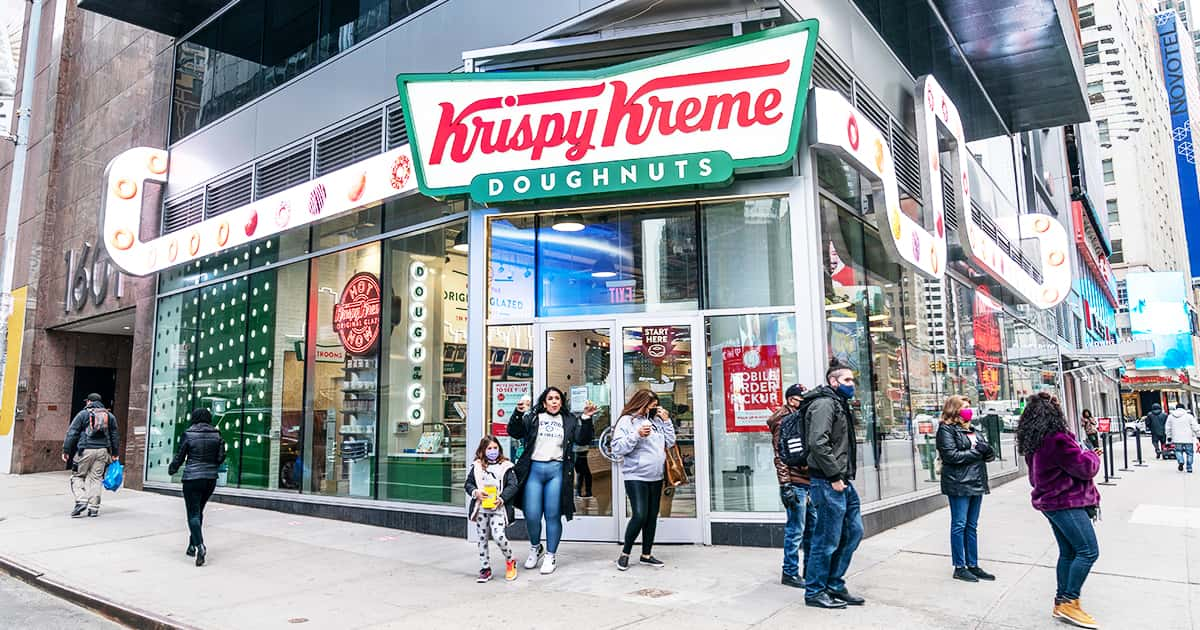
Krispy Creme Is Not Worried About Inflation, And Here's Why
Krispy Creme Is Not Worried About Inflation, And Here's Why
It seems that everyone in the U.S. is worried about rising inflation. According to the Bureau of Labor Statistics, the Consumer Price Index (CPI) showed a whopping 7.5% annual gain in January of this year, representing the fastest rise seen in the past four decades.
As concerning as that may be, Mike Tattersfield, the CEO of Krispy Kreme, is not worried at all. Speaking to Yahoo Finance, he explained that customers are visiting his donut shops infrequently enough that he is able to keep higher prices on their baked goods.
"The average user visits a Krispy Kreme two and a half times a year," he said, explaining that most of its customers view the brand as more of a go-to for celebratory occasions rather than a daily stop-and-shop. This means that the company sees more business during annual events such as Valentine's Day, Halloween, and Christmas, which in turn lends the company some degree of "pricing power."
"We really absolutely maximize the opportunities when it's around Halloween when it's around the holiday season when it's around Valentine's Day ... our number one day in the world. It's about a celebration...it's about a shared experience," Tattersfield added.
Krispy Kreme's prices went up just last September and November, a move that was aimed to offset wage and commodity inflation. Tattersfield says the company plans to introduce even more price increases this year as inflation continues to accelerate.
The company saw revenue gains of 13.8% in the fourth quarter (ending on January 2, 2022), as well as a 23% increase in new revenue for 2021. Yet, despite its slow transition into a somewhat novelty brand, Krispy Kreme still plans to expand its operations into grocery stores to maximize its daily business. The ongoing pandemic has had a negative impact on Krispy Kreme's business, specifically in terms of the company's foot traffic, which saw a 17.54% drop in the week of January 10, 2022 compared to 2020.
R.J. Hottovy, the Head of Analytical Research at data intelligence platform Placer.ai, says that Krispy Kreme's data was "more or less consistent with trends from the broader restaurant industry" during the time when Omicron was dominant. Still, the brand has a long way to go before it can return to its pre-pandemic shape, as shares of the company continue to be down 22% since it went public on the Nasdaq in June of 2021.
READ MORE

As the crisis continues, airlines are hemhorraging money. Will airlines survive this crisis? And if so, how?

If you're looking to expand your buying power, you need to check out the best credit cards of 2020. You won't believe some of these extras!

Whether it's an incompetent client or an unhinged attorney, these lawyers' stories of their most outrageous plot twists had us banging the gavel.

There is a reason why shows like Gray's Anatomy and ER are so addictive: Hospital drama is insane, and not just on TV—that stuff happens in real life, too.

Courtroom cases can take months or even years to go in front of a judge. Then, in the blink of an eye, it can all unravel spectacularly.

On TV, courtrooms seem like well-oiled machines. In real life, though? Not so much. These court cases are wild rides from start to finish.
Disclaimer
The information on MoneyMade.com is intended to support financial literacy and should not be considered tax or legal advice. It is not meant to serve as a forecast, research report, or investment recommendation, nor should it be taken as an offer or solicitation to buy or sell any securities or adopt any particular investment strategy. All financial, tax, and legal decisions should be made with the help of a qualified professional. We do not guarantee the accuracy, timeliness, or outcomes associated with the use of this content.
Dear reader,
It’s true what they say: money makes the world go round. In order to succeed in this life, you need to have a good grasp of key financial concepts. That’s where Moneymade comes in. Our mission is to provide you with the best financial advice and information to help you navigate this ever-changing world. Sometimes, generating wealth just requires common sense. Don’t max out your credit card if you can’t afford the interest payments. Don’t overspend on Christmas shopping. When ordering gifts on Amazon, make sure you factor in taxes and shipping costs. If you need a new car, consider a model that’s easy to repair instead of an expensive BMW or Mercedes. Sometimes you dream vacation to Hawaii or the Bahamas just isn’t in the budget, but there may be more affordable all-inclusive hotels if you know where to look.
Looking for a new home? Make sure you get a mortgage rate that works for you. That means understanding the difference between fixed and variable interest rates. Whether you’re looking to learn how to make money, save money, or invest your money, our well-researched and insightful content will set you on the path to financial success. Passionate about mortgage rates, real estate, investing, saving, or anything money-related? Looking to learn how to generate wealth? Improve your life today with Moneymade. If you have any feedback for the MoneyMade team, please reach out to [email protected]. Thanks for your help!
Warmest regards,
The Moneymade team







